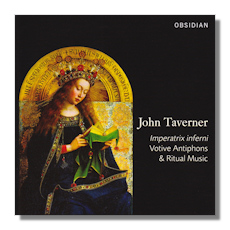
The Internet's Premier Classical Music Source
Related Links
- Taverner Reviews
- Latest Reviews
- More Reviews
-
By Composer
-
Collections
DVD & Blu-ray
Books
Concert Reviews
Articles/Interviews
Software
Audio
Search Amazon
Recommended Links
Site News
 CD Review
CD Review
John Taverner

Imperatrix inferni
Votive Antiphons & Ritual Music
- Quemadmodum
- Audivi vocem
- Ave Dei patris filia
- Dum transisset sabbatum
- Mater Christi
- Gaude plurimum
- [Hodie nobis celorum rex…] Gloria in excelsis Deo
- O splendor glorie
Alamire/David Skinner
Obsidian CD707
If Obsidian carries on like this, it'll have a 100% record. Founded only in the last couple of years, its handful of CDs features such performers as Fretwork; the Choir of Sidney Sussex College, Cambridge; the QuintEssential Sackbut and Cornett Ensemble; Lynda Sayce and Andrew Lawrence King. It is the 13-strong (on these recordings) vocal consort, Alamire, directed by David Skinner which continues the label's winning streak of superb releases of Renaissance this time – in the first of an extremely ambitious and welcome survey of early English church music over a projected 30 volumes.
Imperatrix inferni contains eight votive Marian (the Blessed Virgin Mary is described as the Empress of Hell in the Ave Dei patris) antiphons and associated "ritual" music – largely from the early career of John Taverner, who was probably born at the start of the last decade of the fifteenth century (1490 is likely) and died in 1545. Given his importance in musical development (great textural unity, advanced use of imitation, less rhythmic complexity with more cautious use of syncopation counterposed against more florid detail), Taverner – the embodiment of the end of the English mediaeval polyphonic tradition – is still rather unrepresented on CD, although all the works on this CD do have otherwise recommendable recordings.
Ave Dei patris filia and Gaude plurimum are large-scale marian antiphons and are known to date from the late 1510's and early 1520's – from the period of Taverner's compositions before he spent four years at Cardinal (now Christ Church) College, Oxford. The same is true of Hodie nobis and Audivi vocem; although not so melismatic as some contemporary (English) polyphony, these works do not aim at the transparency of the slightly later Mater Christi, which privileges the text. Later still is almost certainly O splendor glorie with Quemadmodum actually coming towards the very end of Taverner's career. As Taverner modified, developed and extended his compositional sensibilities and strengths, they changed enough for us to be able to date (such) works almost on stylistic grounds alone.
Alamire is on top form here. Each syllable is clear, clean and translucent. Indeed, there is a lot of light to emerge from Taverner's music. The ensemble's greatest achievement, perhaps, is to have blended the essence of this music (its beauty, clarity, affect and sacredness) which should be considered timeless, with the sense of performance, immediacy and the here and now. From the first note of the limpid Quemadmodum [tr.1], the listener is aware that these are real people singing in our presence – perhaps in honor of a real occasion, but certainly not aiming for the sky or an impersonal ideal in the way that some ensembles do, for whom polish is paramount.
This is not to say that Alamire's delivery is in any way ragged or unfinished. Just that it has as much life and verve as it does gentle sophistication. Alongside the particularities of the verses slowly unfolding (they do not emerge; they are "unpacked") comes a sense through evenness of articulation and an unhurried confidence of the architecture of the whole work. Although there is no rush, no haste, the words are never made to dance. Rather each one to count in its own uncluttered diction, taking its own time to make its own impact. Impression and aura rightly come a very long way behind. Taverner is – for Alamire – a quiet superior; while he certainly passes his word from "on high" and is to be respected for being able so to do, the composer is only in this position by recognizing the inherently human in his use of texts. This is exactly what is needed for a composer who saw the polyphonic tradition of the Eton Choirbook to its close and made the crystalline subtleties of Byrd and Tallis possible.
At the same time, the singing style of Alamire is thoroughly approachable and enjoyable. As each work comes to an end (only three last more than ten minutes and only Gaude plurimum [tr.6] more than fifteen), it has been an event in itself; it has communicated something special, something unique; and the next makes all the more sense for the immediacy and impetus of Alamire's singing. Technically impeccable, their approach is also highly expressive and communicative.
The acoustic is as resonant and enhancing – without being even minutely intrusive – as can be expected from the Fitzalan Chapel at Arundel Castle in Sussex (UK); just what music of this beauty, depth and conviction needs. As David Skinner puts it in his informative booklet, which contains the texts in Latin and English translation, "Taverner… was a quiet genius and his surviving music still maintains an emotional charge…" This CD goes a long way towards boosting the composer's standing with 21st-century listeners and is strongly recommended.
Copyright © 2011, Mark Sealey.





















